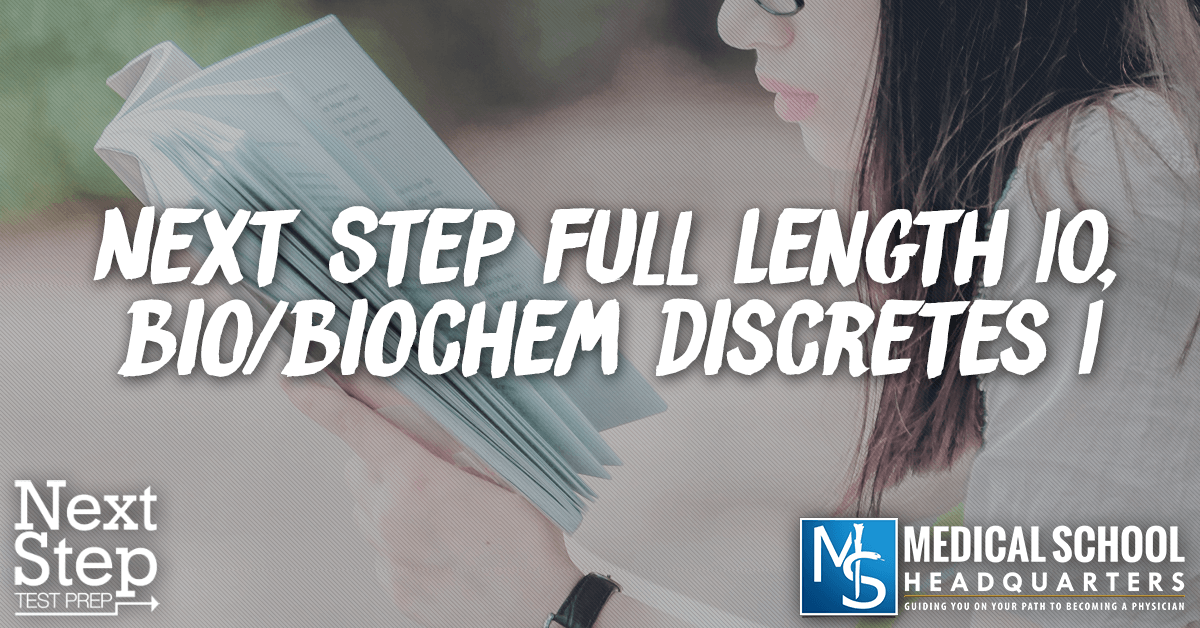Apple Podcasts | Google Podcasts

Session 122
We’re still in bio/biochem mode for the MCAT podcast, this week, covering the first discrete set of questions from the section.
As always, Clara from Blueprint MCAT (formerly Next Step Test Prep) joins us today. Subscribe to all our other podcasts on the MedEd Media Network. I recently got a comment on Instagram from a student who improved her MCAT score after listening to our podcast. No guarantee it would be the same for you, but this could help you too! So be sure to tune in every week.
[02:46] Some General Tips on Discretes
Clara sees a lot of students making the same mistake with discretes because they’re generally so short and seem so easy, as well as content-specific. So they tend to rush. Typically, you’ll hear an advice to do one discrete a minute. But a lot of times, students feel one minute is too long for a discrete so they end up rushing even further. So rushing through a discrete is just doing yourself a disservice. Consequently, if you’re spending a lot of time on discretes and still missing them, then likely your issue is with content.
[03:46] Question 14
Which of the following structures develop from the mesoderm of the gastrula?
- Lungs
- Red blood cells
III. Cardiac muscle
- (A) II only
- (B) I and II only
- (C) II and III only
- (D) I, II, and III
Clara’s insights:
The mesoderm is the germ layer that develops into intermediate transport-related tissues. For instance, the cardiovascular system and the muscle/skeletal system develop from the mesoderm. Hence, the correct answer here is C. Lungs develop from the endoderm.
[06:50] But Anatomy Isn’t a Prereq for Medical School or the MCAT?
Clara recommends that if you have the time, take Anatomy and Physiology to help bolster your knowledge. There isn’t really a ton of this on the MCAT now though. But this can be helpful in a way that it can teach you the way to think on the MCAT.
[08:33] Question 15
Given the role of the reaction in cellular respiration, what is the most likely e standard, an electrical potential value for the reduction of oxygen to water?
- (A) 0.02 V
- (B) 0.82 V
- (C) -0.02 V
- (D) -0.82 V
Clara’s insights:
This isn’t actually a value that you need to memorize. You don’t need to know reduction potential or oxidation potential, or electrical potential. But what they’re getting at here is the reduction of oxygen to water is very spontaneous. This is because oxygen is the terminal electron receptor in the electron transport chain. It’s the substance that’s most likely going to become reduced so it should have all molecules of the change, it should have the highest or most positive reduction potential. So they’re just asking us to make the most positive answer here which is B.
The negative or positive may be mixed up among students and it can be confusing so just remember that positive values are always spontaneous and the negative values always denote non-spontaneity. SO here, we know right away that it can’ be C or D since they’re both negative and the reduction of oxygen to water is very spontaneous.
[11:15] Question 16
Which of the following is the most plausible explanation for a patient experiencing hypoglycemia?
- (A) Accidental self-injection of excess insulin
- (B) Increased gluconeogenesis
- (C) A four-hour fast following a carbohydrate-rich meal
- (D) Increased rate of glycogenolysis
Clara’s insights:
Basically, you want to take the odd one out here. B, C, and D seem like they’re going to cause the same thing, which is to increase blood sugar. Then the answer has to be A.
What could throw off a lot of students here is because of the phrase “most plausible” explanation. And so there could be another answer here that could be close. But that being said Clara points out that the MCAT is a very direct exam. So they’re not definitely going to give you two plausible answer choices and make you decide which is more plausible. There will be three wrong answers and one correct one. So as long as you don’t get caught up in that wording then you should be good.
[14:12] Question 17
In a metabolic analysis experiment, researchers subjected fatty acid samples to beta oxidation. Mass spectrometry performed on the resulting products would reveal:
- (A) Glucose
- (B) Acetyl Co-A
- (C) Pyruvate
- (D) Succinate
Clara’s insights:
The correct answer here is B. Acetyle Co-A is the product of beta oxidation, the breakdown of fatty acids. All the other ones are involved in glycolysis and succinate is involved in the Krebs cycle.
[16:06] Blueprint MCAT (formerly Next Step Test Prep)
Check out Blueprint MCAT (formerly Next Step Test Prep) and the full length ten exams, which you can buy in packs of 4, 6, or 10. Save 10% using the promo code MCATPOD.
Links:
SEARCH SITE
SEARCH SITE
LISTEN FOR FREE











